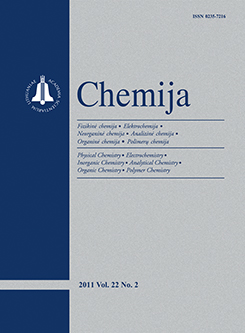Chemija / Chemistry
WHAT?
 ISSN 0235-7216 ISSN 2424-4538 (online) |
2014 m. Nr. 4 Polifenolių prooksidacinis citotoksiškumas pirminiuose pelių splenocituose: redokso potencialo ir lipofiliškumo vaidmuo
Flavonoids and other polyphenolic antioxidants frequently exhibit the prooxidant cytotoxicity in malignant mammalian cells, which increases with an ease of their oxidation (decrease in the redox potential of the phenoxyl radical / phenol couple, E7(Q–./QH2)), and an increase in their lipophilicity (log P or log D). However, little is known about their cytotoxicity in primary cells, although it may help to understand their side effects, and the possible selectivity of their particular structures towards the malignant cells. We found that the 24 h-action of flavonoids (n = 10) and hydroxybenzenes (n = 13) in primary mice splenocytes was described by two separate although scattered quantitative structureactivity relationships (QSARs), each showing the negative dependence of cytotoxicity on the E7(Q– /QH2) of compounds, and a positive dependence on their log D. The cytotoxicity of polyphenols was decreased by antioxidants and inhibitors of cytochromes P-450, α-naphthoflavone and isoniazide, and increased by an inhibitor of catechol-O-methyltransferase, 3,5-dinitrocatechol. Taken together with the QSARs of flavonoids and hydroxybenzenes in several malignant (cancer or virus-transformed) cells, our data point to a limited importance of flavonoids and other polyphenols as possible anticancer agents because their action in primary and transformed (cancer) cells follows the similar trends.
Keywords: flavonoids, polyphenols, antioxidants, cytotoxicity, oxidative stress |
Issues:
2017 - Vol.28 No. 1, No. 2, No. 3, No. 4 2016 - Vol.27 No. 1, No. 2, No. 3, No. 4 2015 - Vol.26 No. 1, No. 2, No. 3, No. 4 2014 - Vol.25 No. 1, No. 2, No. 3, No. 4 2013 - Vol.24 No. 1, No. 2, No. 3, No. 4 2012 - Vol.23 No. 1, No. 2, No. 3, No. 4 2011 - Vol.22 No. 1, No. 2, No. 3, No. 4 2010 - Vol.21 No. 1, No. 2-4 2009 - Vol.20 No. 1, No. 2, No. 3, No. 4 2008 - Vol.19 No. 1, No. 2, No. 3-4 2007 - Vol.18 No. 1, No. 2, No. 3, No. 4 2006 - Vol.17 No. 1, No. 2-3, No. 4 2005 - Vol.16 No. 1, No. 2, No. 3-4 2004 - Vol.15 No. 1, No. 2, No. 3, No. 4 2003 - Vol.14 No. 1, No. 2, No. 3, No. 4 2002 - Vol.13 No. 1, No. 2, No. 3, No. 4 2001 - Vol.12 No. 1, No. 2, No. 3, No. 4 |